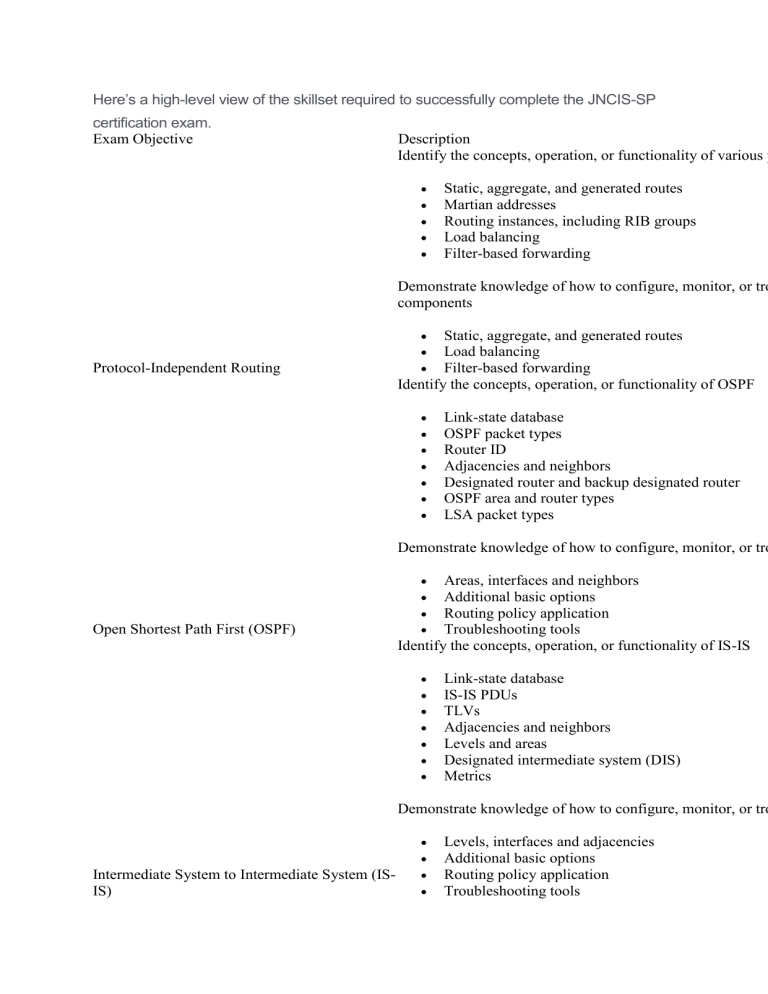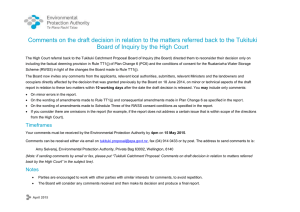
Here’s a high-level view of the skillset required to successfully complete the JNCIS-SP certification exam. Exam Objective Description Identify the concepts, operation, or functionality of various p Static, aggregate, and generated routes Martian addresses Routing instances, including RIB groups Load balancing Filter-based forwarding Demonstrate knowledge of how to configure, monitor, or tro components Protocol-Independent Routing Static, aggregate, and generated routes Load balancing Filter-based forwarding Identify the concepts, operation, or functionality of OSPF Link-state database OSPF packet types Router ID Adjacencies and neighbors Designated router and backup designated router OSPF area and router types LSA packet types Demonstrate knowledge of how to configure, monitor, or tro Open Shortest Path First (OSPF) Areas, interfaces and neighbors Additional basic options Routing policy application Troubleshooting tools Identify the concepts, operation, or functionality of IS-IS Link-state database IS-IS PDUs TLVs Adjacencies and neighbors Levels and areas Designated intermediate system (DIS) Metrics Demonstrate knowledge of how to configure, monitor, or tro Intermediate System to Intermediate System (ISIS) Levels, interfaces and adjacencies Additional basic options Routing policy application Troubleshooting tools Identify the concepts, operation, or functionality of BGP BGP basic operation BGP message types Attributes Route/path selection process IBGP and EBGP functionality and interaction Demonstrate knowledge of how to configure, monitor, or tro Border Gateway Protocol (BGP) Groups and peers Additional basic options Routing policy application Identify the concepts, operation, or functionality of Layer 2 Service provider switching platforms Bridging elements and terminology Frame processing Virtual Switches Provider bridging (for example, Q-in-Q Tunneling) Identify the concepts, benefits, or functionality of VLANs Port modes Tagging MVRP IRB Demonstrate knowledge of how to configure, monitor, or tro Layer 2 Bridging or VLANs Interfaces and ports VLANs MVRP IRB Provider bridging Identify the concepts, benefits, operation, or functionality of STP, RSTP, MSTP and VSTP concepts Port roles and states BPDUs Convergence and reconvergence Spanning-tree security Demonstrate knowledge of how to configure, monitor, or tro Spanning-Tree Protocols Multiprotocol Label Switching (MPLS) Spanning-tree protocols: STP, RSTP, MSTP, and VS BPDU, loop, and root protection Identify the concepts, operation, or functionality of MPLS MPLS terminology MPLS packet header End-to-end packet flow and forwarding Labels and the label information base MPLS and routing tables RSVP LDP Demonstrate knowledge of how to configure, monitor, or tro MPLS forwarding RSVP-signaled and LDP-signaled LSPs Identify the concepts, operation, or functionality of IPv6 IPv4 versus IPv6 Address types, notation, and format Address scopes Autoconfiguration Tunneling Demonstrate knowledge of how to configure, monitor, or tro IPv6 Interfaces Static routes Dynamic routing: OSPFv3, IS-IS, and BGP IPv6 over IPv4 tunneling Identify the concepts, requirements, or functionality of IP tu Tunneling applications and considerations GRE IP-IP Demonstrate knowledge of how to configure, monitor, or tro Tunnels GRE IP-IP Identify the concepts, benefits, applications, or requirements Link aggregation groups (LAG) and multichassis LA Graceful restart (GR) Graceful Routing Engine switchover (GRES) Nonstop bridging (NSB) Nonstop active routing (NSR) Bidirectional Forwarding Detection (BFD) Virtual Router Redundancy Protocol (VRRP) Unified In-Service Software Upgrade (ISSU) Demonstrate knowledge of how to configure, monitor, or tro High Availability LAG, MC-LAG GR, GRES, NSB, and NSR VRRP ISSU



